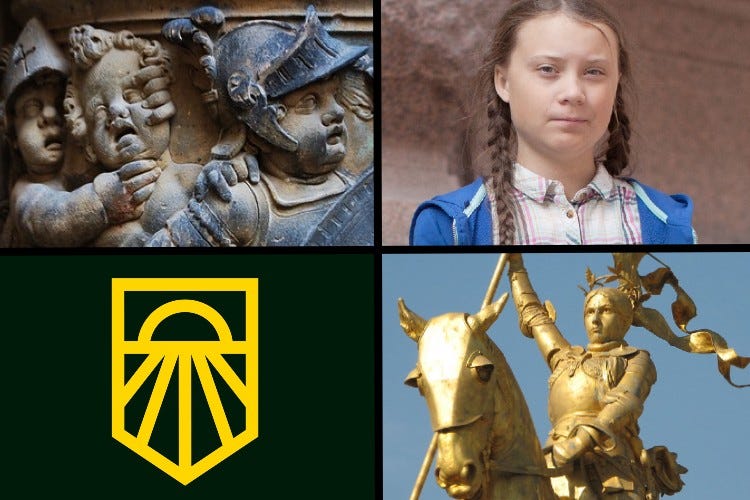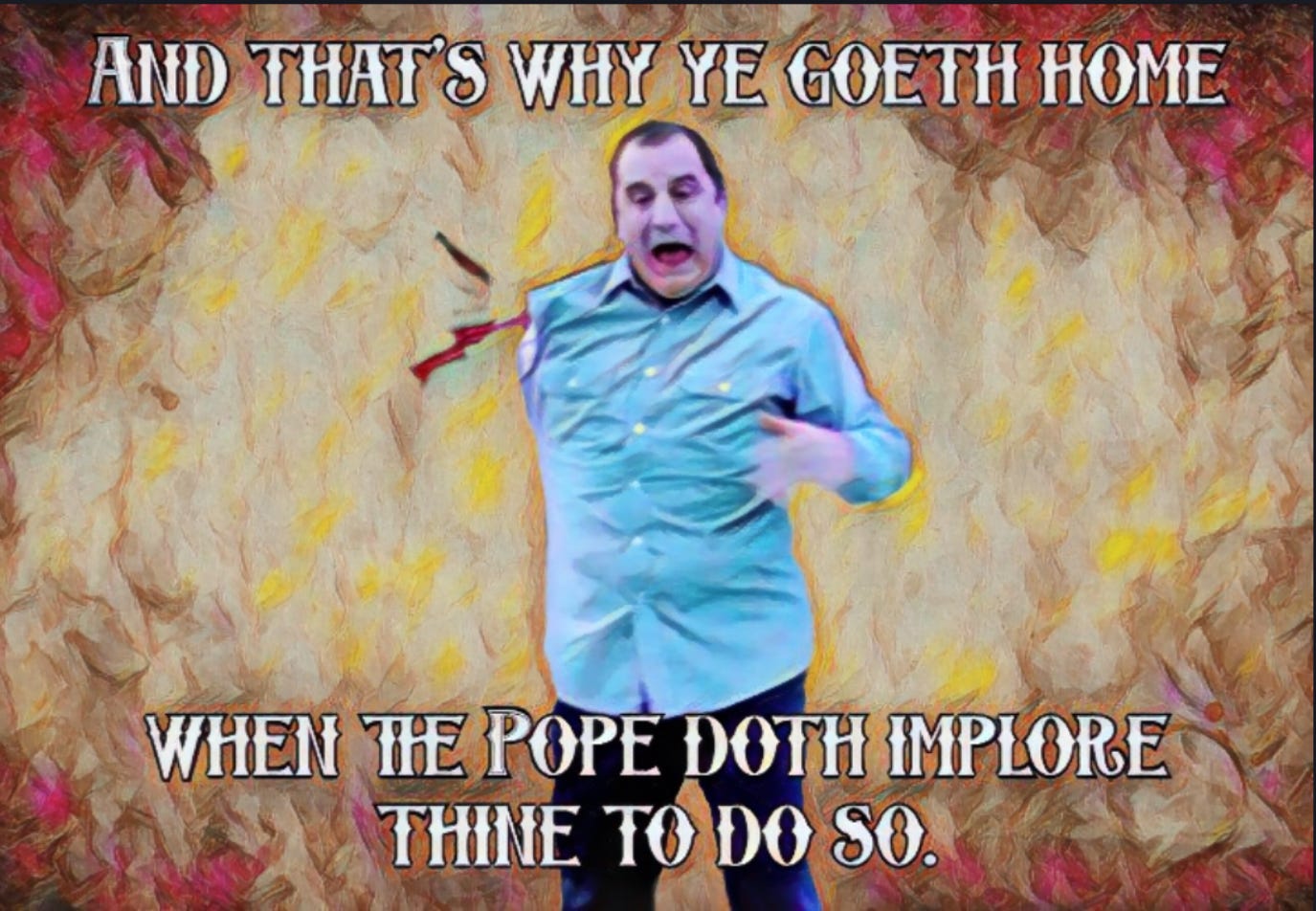
It’s been a rough week or so for young people in politics. In Amsterdam, Greta Thunberg shared a stage with an activist who had previously called the October 7 attacks “resistance” and who celebrated the terrorist Leila Khaled, who once threw a live grenade into an airplane full of civilians. Then, Osama bin Laden’s “Letter To America” went viral on Tik Tok, gaining favorable reviews from some young influencers 21 years after it was published. Published by Osama bin Laden. Yes, that Osama bin Laden.
On the other hand: Has it been a bad week for young people in politics? Or has it been a completely normal week for young people in politics? You can argue that it’s been the latter, because when the very young get political, the historical results are not good. Personally, I think it’s obvious that a political movement led by kids is about as likely to succeed as a basketball team led by elderly diabetics. But this is apparently not obvious to everyone. So, I’m offering a brief synopsis of a few child-led political movements that will hopefully put the phenomenon of politically-involved minors in perspective.
The Children’s Crusades
In 1212, movements arose in France and what is now Germany to march to the Holy Land and convert Muslims to Christianity. These movements differed from previous Crusades in that they were (allegedly) led by and comprised of children. They were similar to previous crusades in that they failed catastrophically.
Anyone who has traveled with kids knows that a kiddie crusade is an awful idea. Kids are astoundingly bad travelers; a trip from Europe to the Middle East today would leave a trail of misplaced inhalers and Nintendo DSs at hotels and restaurants from Berlin to Jerusalem. Medieval pre-teens were obviously never going to pack enough toiletries, warm clothes, and Go-Gurt packets for a trans-continental walk. Which is probably why the Pope and the King of France told them not to go. But despite the protests of ostensibly the two most powerful men in Europe, a 12 year-old named Stephen of Cloyes gathered perhaps 30,000 children in Saint-Denis and marched south. Unfortunately, the same thing happened that usually happens when kids get their way: They were sold into slavery by Mediterranean pirates.1 Let that be a lesson, kids: Do what adults say, or you’ll be sold into slavery by Mediterranean pirates.
A similar thing happened in the German territories. A boy known as Nicholas of Cologne assembled a group of children and — once again acting without Papal authority — set out for the Holy Land. Many of the children died in the Alps, and they didn’t even have the excuse of having The Sound of Music trick them into thinking that crossing the Alps is easy. Some of the children made it as far as the Mediterranean, where Nicholas assured them that the water would part, like in the bible. But guess what? The sea didn’t part. The group disbursed, and Nicholas was hanged by families who had a bee in their bonnet about him leading their children to their deaths. It was a tragic episode that certainly should have inspired this painting (though historians have no evidence that it did):
Joan of Arc
During the Hundred Years War, a 17 year-old peasant girl named Joan joined the army supporting Charles VII of France. In 1429, Joan was part of an army sent to relieve the sieged city of Orléans. Soon, Joan emerged as a figurehead who boosted morale, and though she held no formal command, she often advised the army’s commanders. Joan’s advice was heeded when she urged an attack on a fortress protecting Orléans, and the attack was a major success. Following their victory, some leaders argued for consolidating their gains, but Joan urged another attack. This attack was also successful, and soon Orléans was liberated. A campaign in the Loire Valley followed, and Joan’s repeated calls for attacks led to a string of victories for Charles’ army. Joan’s stature grew despite the fact that her council appeared to be no different than that of a parrot that had been taught to squawk “ATTACK!”
As Charles’ army approached Paris, Joan called for — you guessed it — an attack. Charles took Joan’s advice, but this time, the attack failed. This caused skeptics within Charles’ court to suggest that maybe — just maybe — Joan was not a divine presence sent by God. This suspicion gained further credence at the town of La-Charité-sur-Loire, where Joan called for — wait for it — an attack, which failed. Now only sort-of acting with Charles’ blessing, Joan led an army to the town of Compiègne and called for — you’re never going to guess what she called for, it’s gonna blow your mind — an attack. That attack failed, and Joan was captured and prosecuted under England’s draconian “three strikes and you’re burned at the stake” law.
God’s Army of the Holy Mountain
In the late ‘90s, a group of guerilla warriors called God’s Army of the Holy Mountain arose among the Karen ethnic group in eastern Myanmar. God’s Army was led by nine year-old twin boys named Johnny and Luther Htoo. The boys claimed to have magical powers, such as being immune to bullets and being able to kill people with their minds (reporters were unable to verify those claims). Johnny said that he could magically transform into an old man, which might be the strangest superpower that anyone has ever claimed; it’s not clear what benefits transforming into an old man gets you, except for $1 coffee at McDonald’s. The boys practiced an ascetic form of Christianity and demanded strict adherence to the Bible, especially the part of the Bible where Jesus bursts into a hospital with an AK-47 and takes a bunch of hostages, which is one of the things that God’s Army did.
By 1998, God’s Army had 500 soldiers. That is: They had 500 flesh and blood soldiers, plus 400,000 invisible soldiers that Johnny and Luther claimed to command (again, reporters were unable to verify that claim). But somehow, the plucky and lovable armed forces of Myanmar routed God’s Army with only 21,000 soldiers. Ultimately, Johnny and Luther’s legacy didn’t extend far beyond AP photographer Apichart Weerawong’s iconic photo of the boys (below), which is just begging to be put on a t-shirt and sold at Hot Topic.
What can we learn from this? Obviously, we can learn that putting your faith in a kid-led political movement is about as wise as putting your head in a barrel full of cobras. Consider that the best outcome in the examples above was “sold into slavery by Mediterranean pirates”. Kids are good at many things, such as being adorable, sewing Nikes, and shimming into ductwork to retrieve dead animals. But they don’t belong in politics.
Incredibly, not everyone agrees with this! I spent much of 2018 defensively explaining that I was actually not enamored by Greta Thunberg, the Parkland teens, or the Sunrise Movement. I didn’t dislike them, per se — I had no opinion of them at all. Because they were children. You should have seen the faces people made when I told them that I — a person who cares about climate change — was not charmed by the precocious Swedish teen who arrived on a magic sailboat to scold the carbon out of the atmosphere. You would think that I had said that Dolly Parton should be kicked down a flight of stairs.
I’m not too bothered by Zoomers who see bin Laden as underrated and overlooked, sort of the Hüsker Dü of mass murder. Young people are stupid, have always been stupid, and will always be stupid, amen. I’m bothered by adults who bleat “listen to the children!” and expect to be taken seriously. I’m also bothered by adults who feel the need to aggressively dunk on idiotic minors. Neither of those things is appropriate; the correct response to an ignorant teenager (which is to say: a teenager) who decides to try on their social justice warrior outfit is to say “thank you for your thoughts” and then ignore them. The “wise child” trope is pretty damn obnoxious when it appears in a movie and utterly fucking intolerable when someone expects you to believe it in real life.
I plan to cite this article the next time someone tries to gain political leverage by using a child as a totem. I don’t know what the context will be when that happens; maybe a really mean 8th grader will gain notoriety making anti-Biden Tik Toks, or maybe a toddler will fly a blimp around the world to protest Social Security reform. Regardless of the context, some adults will cry “listen to the children!” and hope that people are too afraid of looking like a dick to say “No, I will not listen to them”. This column is my a priori declaration: I am not too afraid of looking like a dick. Moreover, I believe that people who use kids to gain leverage in a political dispute are, in fact, the dicks. And I feel that history suggests that this is the right position to take.
Records of the Children’s Crusade are so spotty that it’s difficult to tell exactly what happened to the group led by Stephen of Cloyes, but there are reports of some from his group making it to Marseilles and being sold into slavery.






It is *absolutely* appropriate to dunk on stupid teenagers who broadcast their dumb opinions--without constant reminders that their opinions are wrong and worthless, those kids will grow up to be NYT staffers who demand editorial resignations for publishing a sitting U.S. Senator.
What's even worse is an obese, 77 year old man who never outgrew his toddler mind.